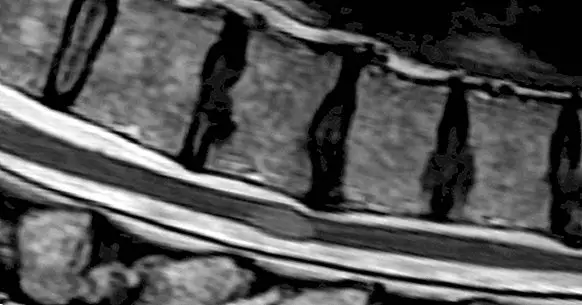Transverse myelitis: what it is, symptoms, causes and treatment
Transverse myelitis is a disease of the spinal cord that causes symptoms such as muscle pain and weakness; in the most serious cases these alterations can be maintained throughout life.
In this article we will describe What is transverse myelitis, what are its symptoms and main causes and in what way it can be treated.
- Related article: "Myelin: definition, functions and characteristics"
What is transverse myelitis?
Myelitis are diseases that consist of inflammation of the spinal cord , whether this is the cause of the patient's symptoms or a consequence of another disorder of the central nervous system.
The name "myelitis" comes from the fact that they are often affected nerve fibers covered with myelin sheaths , a substance that isolates axons and facilitates the transmission of electrochemical impulses between neurons.
"Transverse myelitis" is the term used to refer to this disease when inflammation occurs on both sides of a section of the cord. We speak of partial transverse myelitis when the inflammation extends to both sides of the spinal cord but incompletely.
In general, damage is limited to a small area of the spinal cord , although the severity of myelitis varies depending on the case. The interruption in sending signals along the spine causes alterations and physical deficits of various kinds.
- Related article: "The 15 most frequent neurological disorders"
Symptoms and main signs
The symptoms of transverse myelitis usually affect both sides of the body below the damaged section of the cord. Although in general the development of these symptoms occurs in a matter of hours or days, sometimes it is slower, being able to take weeks to evolve completely.
1. Pain
In many cases, transverse myelitis is detected by the sudden onset of severe, throbbing pains in the lower back and legs . Depending on the part of the affected marrow, pain may occur in other parts of the body, such as the chest and abdomen.
- Related article: "Chronic pain: what it is and how it is treated from Psychology"
2. Muscular weakness
Muscle weakness usually affects the legs, which causes sensations of heaviness in the lower extremities and difficulty walking. If the damaged section is located in an elevated part of the medulla, weakness may also occur in the arms.
3. Paralysis
In the context of transverse myelitis muscle paralysis occurs as a progression of weakness in the extremities , particularly in the legs. When the paralysis is partial we speak of paraparesis, while if it is complete the correct term is paraplegia.
4. Sensory alterations
Abnormal sensations that can appear as a result of myelitis include tingling, numbness, itching, burning and sensitivity to intense heat and cold. The parts of the affected body of habitual form are the legs, the torso and the genitals. It is also common for sensory deficits to occur.
5. Sphincter dysfunction
Alteration in bladder and bowel function it manifests itself in the presence of urinary incontinence, difficulties to urinate and defecate and constipation.
Causes of this disease
Most cases of transverse myelitis occur as a consequence of disorders that affect the nervous system. However, sometimes there is no identifiable cause; in these cases we speak of "idiopathic transverse myelitis".
1. Immune system disorders
There are many immune alterations that are related to the inflammation of the spinal cord. Between these Post-infectious and post-vaccinal reactions stand out and multiple sclerosis, to which we dedicate a separate section.
Transverse myelitis may also occur as a result of autoimmune disorders such as systemic lupus erythematosus, optic neuromyelitis and Sjogren's syndrome.
2. Multiple sclerosis
Multiple sclerosis is a particularly frequent immune disorder that causes the destruction of the myelin sheaths that surround the axons of the central nervous system. When this disease is present, it is common for transverse myelitis to appear as one of its first signs.
3. Viral and other types of infections
Virus infections are a common cause of transverse myelitis, which usually occurs during the recovery period. Herpetic viruses such as chickenpox and cytomegalovirus are some of the most common in this regard.
In addition, bacterial infections (such as syphilis and tuberculosis), fungi (such as cryptococci) and parasites (such as toxoplasmosis) can also cause inflammation of the marrow. However, this problem is more frequent in viral infections.
4. Other inflammatory diseases
Systemic lupus erythematosus, mixed connective tissue disease, sarcoidosis, scleroderma, Sjogren's syndrome, among other diseases, can also cause inflammation of nerve fibers in the spinal cord. In many cases these disorders are related to the immune system .
Treatment of transverse myelitis
Although transverse myelitis can cause chronic problems, if the treatment starts early the symptoms and signs usually reduce in a matter of weeks, although it can take almost two years to completely remit. The prognosis is worse in case there is no improvement after about five months of treatment.
The treatment of transverse myelitis usually consists in the administration of medications combined with physical rehabilitation therapy , which aims to improve muscle strength and coordination. Sometimes it is necessary to use assistive devices, such as crutches or wheelchairs, temporarily or permanently.
Some of the most used drugs in the treatment of myelitis are the Intravenous corticosteroids such as methylprednisolone and dexamethasone , which can reduce the inflammation of the marrow. The specific medications used will depend on the cause; thus, if the disease is due to a virus, antivirals will be administered.
When the organism does not respond adequately to corticosteroids, a plasma exchange therapy (plasmapheresis) can be applied, which consists in extracting blood plasma and replacing it with special fluids. In this way it is intended to eliminate the antibodies responsible for spinal inflammation.
In addition, drugs are frequently administered to treat secondary symptoms; for example, analgesics and muscle relaxants are used to reduce pain , and if there are sexual or psychic dysfunctions present, specific medications can be prescribed for these alterations.



















